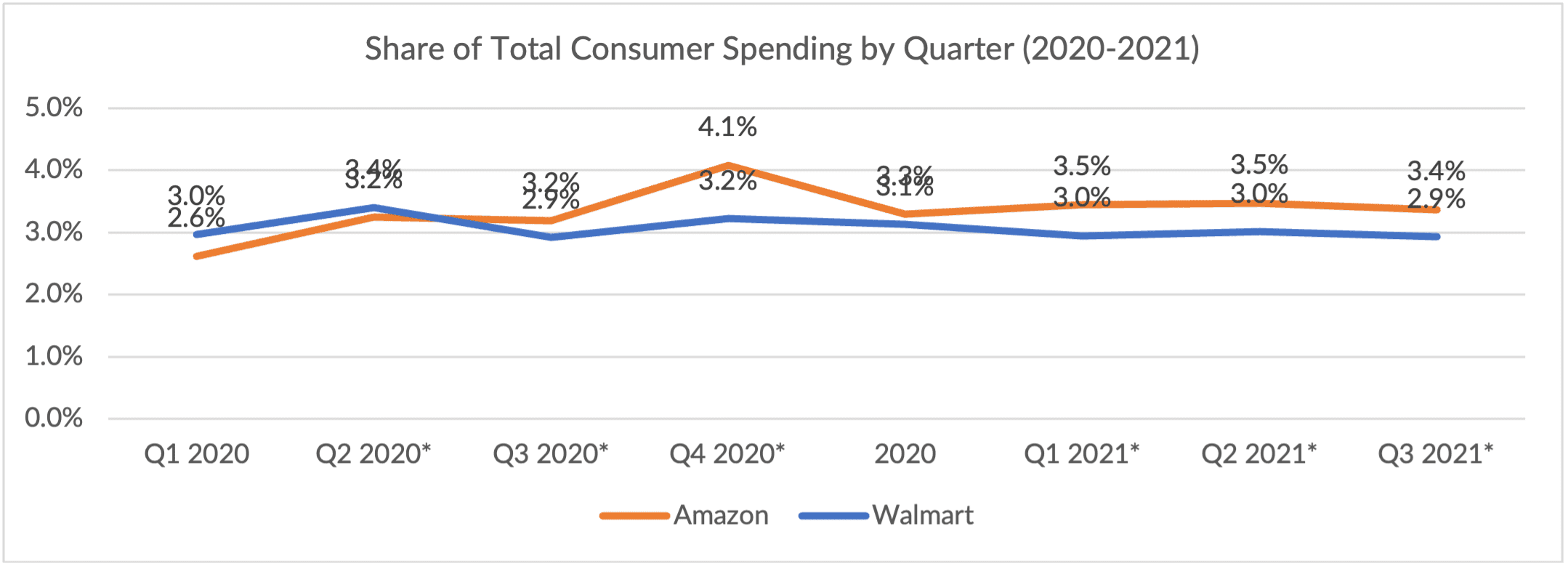
After three quarters in a row of lagging behind Amazon in the race for consumers’ retail spending, it’s all but assured that 2021 will prove to be the first year in decades that Walmart is not the largest retailer in the U.S.
Fourth-quarter results are still weeks away, and much of the peak holiday shopping season has yet to unfold, but Walmart has been stuck with around 8.5% of retail spending for much of this year, while Amazon has consistently hovered around 9%. Additionally, nearly 71% of this year’s Black Friday shoppers made online purchases at Amazon, while only 41% made digital purchases and 59% shopped in-person at Walmart.
Read more: Black Friday Results Put Pressure on Walmart to Keep up With Amazon
And: Amazon Finally Matches Walmart for Consumer Retail Sales
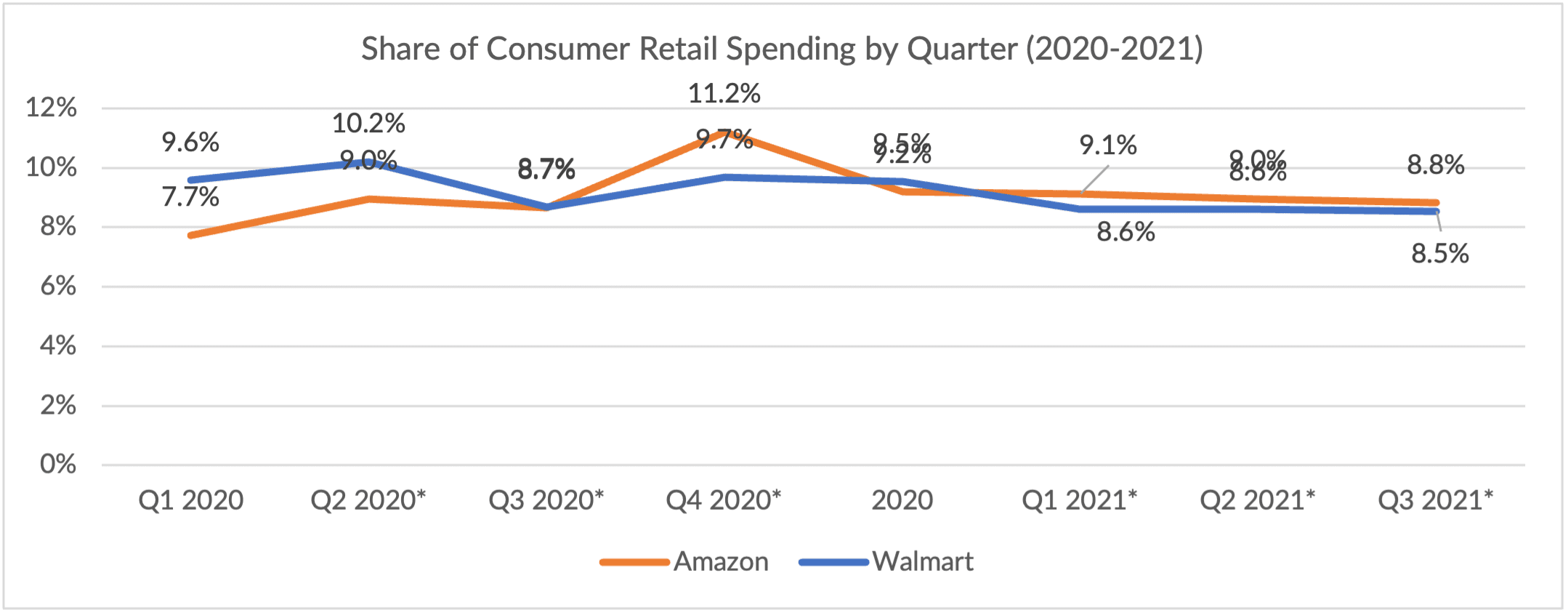 PYMNTS’ proprietary data are derived from a gross market value standpoint, which tracks the full value of everything sold, not the actual revenue the companies earn by way of partial commissions on items sold through third parties on their platforms. For example, if Amazon sold a $50 set of knives but only booked $5 in revenue, assuming it charged the merchant a typical 10% referral fee, PYMNTS’ use of the former metric provides a more holistic view of where consumers are actually spending their money.
PYMNTS’ proprietary data are derived from a gross market value standpoint, which tracks the full value of everything sold, not the actual revenue the companies earn by way of partial commissions on items sold through third parties on their platforms. For example, if Amazon sold a $50 set of knives but only booked $5 in revenue, assuming it charged the merchant a typical 10% referral fee, PYMNTS’ use of the former metric provides a more holistic view of where consumers are actually spending their money.
On an annual basis, as of 2020, Walmart had a 9.5% share of consumer retail spending versus Amazon’s 9.2% share.
 Amazon’s Dominance
Amazon’s Dominance
The categories in which Amazon’s lead over Walmart is the largest are areas that are typically the hottest around the holidays: electronics, toys and hobby equipment, and clothing and apparel. In fact, PYMNTS’ Black Friday study found that two-thirds of consumers plan to buy clothing this holiday season, 33% plan to buy toys or hobby equipment, and 26% plan to buy consumer electronics.
See more: Inventory Stockouts Cost Retailers up to $4.6B on Black Friday
In electronics, Amazon has had the lead for years; the eCommerce giant has seen its share rise from less than 10% in 2014 to over 25% in 2020. Meanwhile, Walmart’s share has declined from just over 9% to less than 6% over the same time period.
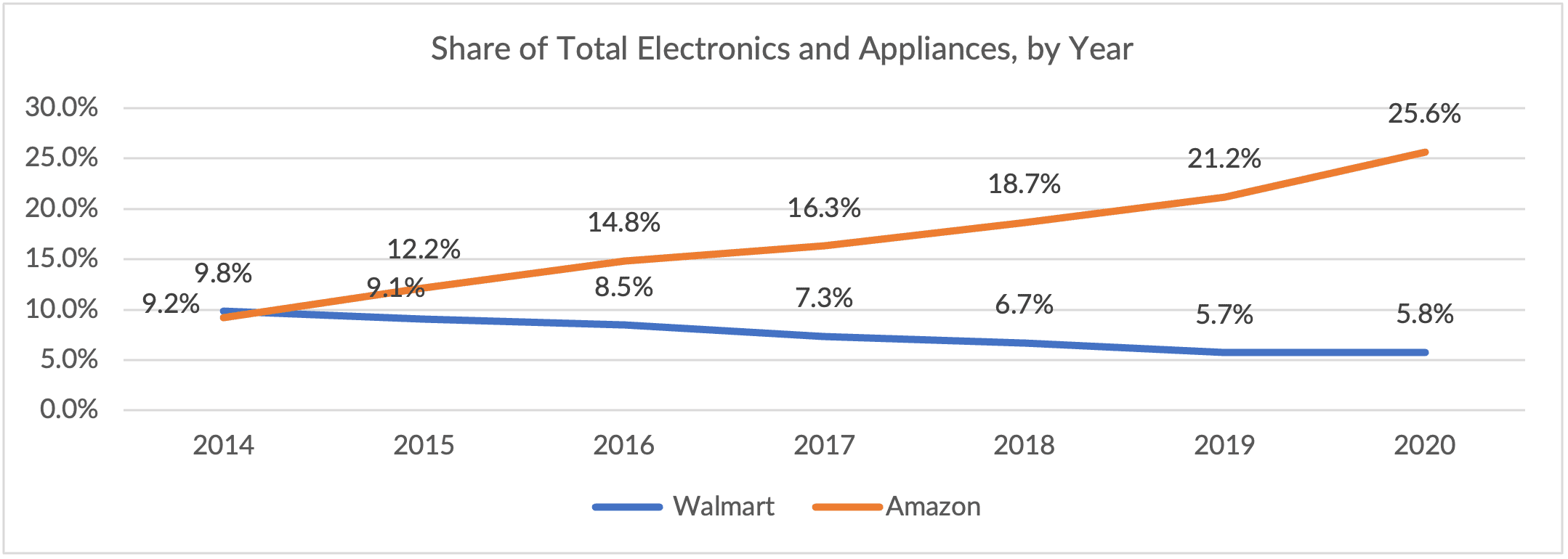 Amazon’s dominance in clothing and apparel is a more recent development, having only occurred in 2018, but the pandemic helped the company bolster its strength as most consumers were forced to shop only online for much of 2020. Amazon’s share of the clothing and apparel category peaked in the fourth quarter of 2020 and has been steadily declining since as shoppers return to brick-and-mortar stores, but Walmart has also seen its share of the market decline, leading to a minimal closing of the gap.
Amazon’s dominance in clothing and apparel is a more recent development, having only occurred in 2018, but the pandemic helped the company bolster its strength as most consumers were forced to shop only online for much of 2020. Amazon’s share of the clothing and apparel category peaked in the fourth quarter of 2020 and has been steadily declining since as shoppers return to brick-and-mortar stores, but Walmart has also seen its share of the market decline, leading to a minimal closing of the gap.
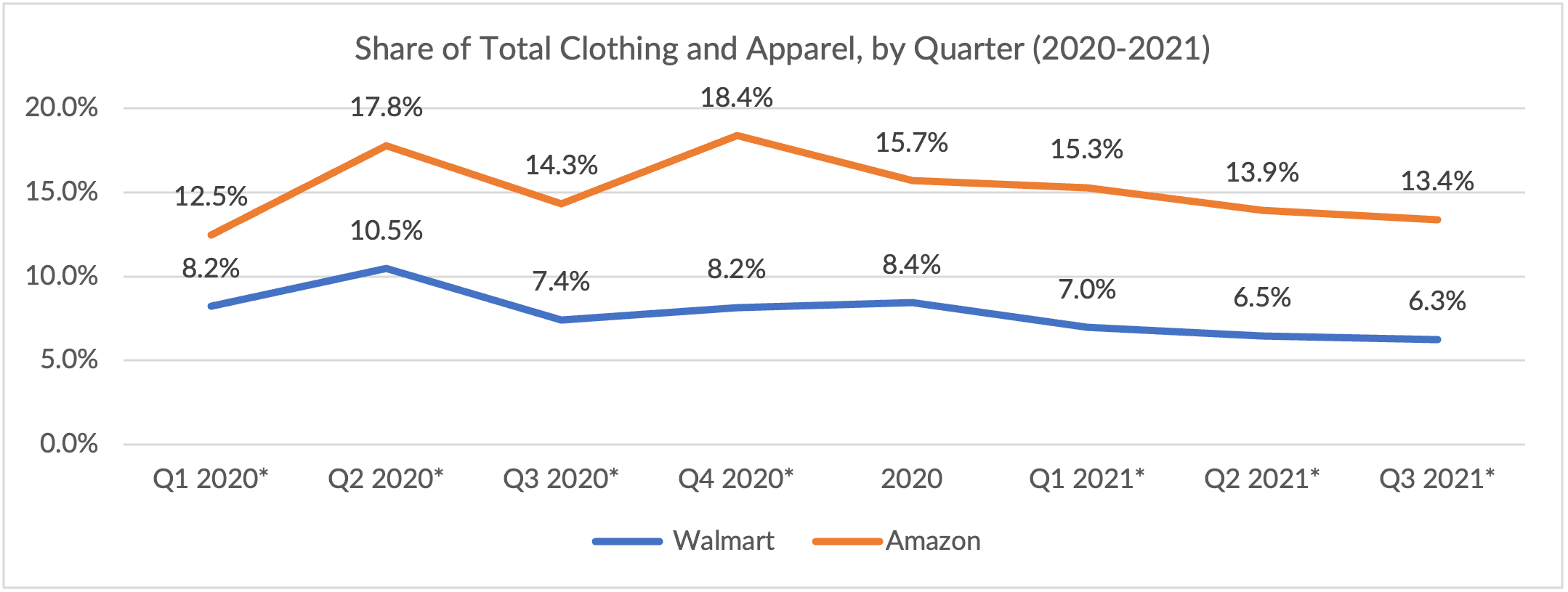 Walmart’s Last Leads
Walmart’s Last Leads
Walmart isn’t completely behind the eight ball, though — it still retains its title as the dominant U.S. grocer, an area that Amazon has struggled to break into despite its 2017 acquisition of Whole Foods and a slew of Amazon Go locations. At the end of the third quarter, Walmart had a nine-to-one lead over Amazon in sales of food and beverage.
Still, Walmart’s share of grocery sales has slipped slightly over the past several months after peaking at over 20% in the fourth quarter of 2020. While the Arkansas-based retailer has consistently seen its share at around 19% for years, it slipped below that threshold earlier this year and has yet to come back.
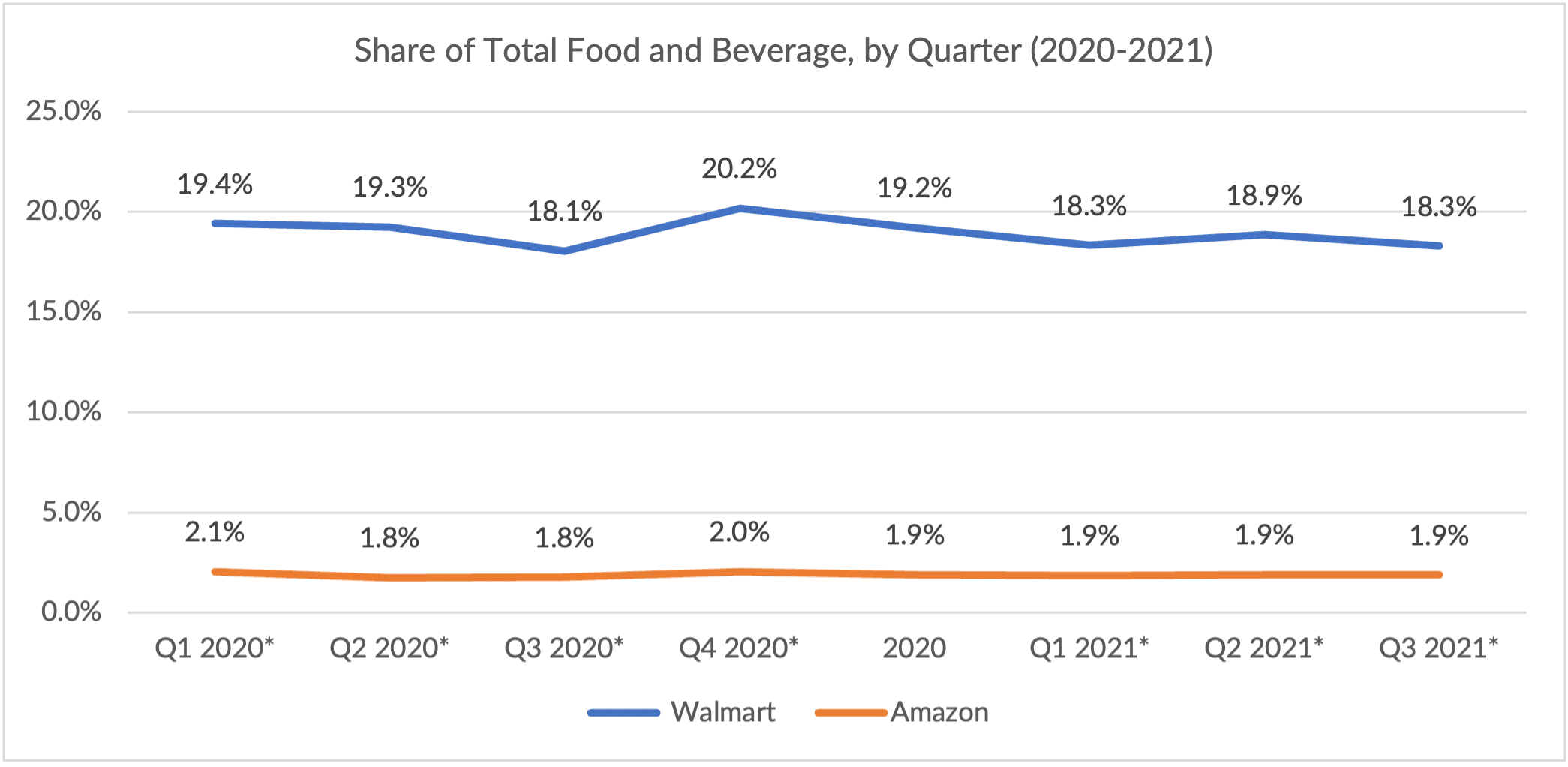 However, Walmart executives say the internal numbers show that its lead in grocery is growing, especially as it targets consumers who are put off by rising prices.
However, Walmart executives say the internal numbers show that its lead in grocery is growing, especially as it targets consumers who are put off by rising prices.
“Our unit growth in grocery is growing faster than dollars, and that’s our position we’d like to stay in as long as we possibly can,” John Furner, president and CEO of Walmart U.S., told analysts on a conference call last month. “We want to keep prices low for customers all across the business, and we’ll be the last to go up.”
See more: Walmart Leverages Scale in Grocery to Price out Competitors
Still, as PYMNTS has previously reported, Walmart’s dominance in food and beverage likely won’t keep Amazon from overtaking it — too many other categories have been lost to the eCommerce colossus, and consumers show no signs of slowing their digital shopping adoption.
Read more: Grocery Strength Likely Won’t Help Walmart Keep Amazon at Bay
Beyond Retail
Both Amazon and Walmart are also investing in areas beyond retail to capture even more of consumers’ spending; after all, retail is but one-third of what people spent in 2020.
Housing, at nearly 20%, takes up the next largest share of consumers’ spending, followed closely by healthcare — an area in which the two retail titans are particularly interested — at 16%.
Walmart in particular has been on a tear in recent months, acquiring telehealth provider MeMD in May, rolling out private label insulin in June and partnering with health records platform Epic to create a portal for Walmart Health members in September, to name a few initiatives.
“Our vision to provide best-in-class healthcare, anywhere, anytime, includes a seamless experience for our customers, healthcare professional partners and associates,” Dr. Cheryl Pegus, executive vice president for Walmart Health & Wellness, said in a statement when announcing the partnership with Epic.
Related news: Post-Walmart Acquisition, MeMD CEO Shares Vision for Omnicare Healthcare Delivery Model
Amazon has also been steadily ramping up its healthcare offerings, though in a more subdued fashion than its box store rival. Through its Amazon Web Services division, the company is working to build a digital infrastructure that can be used by hospitals to manage records, assist with procedures and use artificial intelligence (AI) to predict when a person may become sick. Amazon also offers a telehealth service, Amazon Care, to its employees and other partner companies, as well as an online pharmacy.
See more: Amazon Makes Latest Healthcare Play in Telemedicine
In the third quarter, Amazon had a 3.4% share of total consumer spending compared to Walmart’s 2.9%, approximately the same shares each company had at this point last year.
